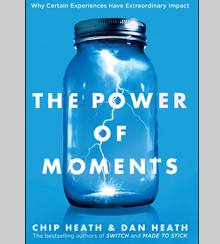strategy + business, November 22, 2017
by Theodore Kinni
 Quick question. Customers rank their interactions with your company on a scale of 1 (very negative) to 7 (very positive). Should you invest more resources in improving the experiences of customers who rank their interactions at a 1, 2, or 3, or those who rank them at a 4, 5, or 6?
Quick question. Customers rank their interactions with your company on a scale of 1 (very negative) to 7 (very positive). Should you invest more resources in improving the experiences of customers who rank their interactions at a 1, 2, or 3, or those who rank them at a 4, 5, or 6?
When brothers Chip and Dan Heath, a professor at Stanford Graduate School of Business and a senior fellow at Duke University’s CASE Center, respectively, asked executives how they invest their resources, the executives estimated that, on average, their companies spend 80 percent of their resources trying to improve the experiences of their unhappiest customers. Yet, report the Heaths, in 2016, when Forrester Research tabulated its annual U.S. Customer Experience Index and modeled the financial results in 16 industries, it discovered that “there’s nine times more to gain by elevating positive customers than by eliminating negative ones.”
This finding supports the main point in The Power of Moments, the latest in a series of formulaic but insightful books by the Heaths that seek to illuminate questions with important business ramifications, such as how to make ideas sticky and how to create change successfully. The point in this case is that “positive defining moments” can produce extraordinary effects in both individuals and organizations. The book explains how such moments are created. Read the rest here.
Sunday, November 26, 2017
Creating Positive Moments for Your Customers
Posted by
Theodore Kinni
at
2:09 PM
0
comments
![]()
Labels: bizbook review, books, change management, corporate life, corporate success, customer experience, personal success, selling, strategy+business, work
Wednesday, November 8, 2017
The €1 trillion challenge in European banking
strategy&, November 8, 2017
Learned a lot lending an editorial hand on this whitepaper.
Download or read it here

Posted by
Theodore Kinni
at
1:55 PM
0
comments
![]()
Labels: corporate success, financial services, innovation, management
Wednesday, November 1, 2017
Four Ways Nonprofits Can Increase Their Impact
Insights by Stanford Business, November 1, 2017
by Theodore Kinni

Only a mere 50 years ago were philanthropic and charitable organizations in the U.S. defined as an independent sector distinct from government and business. Since then, the economic impact of the nonprofit sector in the U.S. has grown to $1.7 trillion.
The sector’s sheer heft — it’s larger than the banking and retailing industries — is one reason that Stanford GSB alumni and lecturers Bill Meehan and Kim Starkey Jonker wrote Engine of Impact: Essentials of Strategic Leadership in the Nonprofit Sector, which came out this November. Another is their conviction that the sector has entered a new era, which they’ve named the “Impact Era.”
The good news of the Impact Era is that, by 2025, philanthropists will likely contribute a record $500 billion to $600 billion annually to nonprofits, well above the $373 billion recorded in 2015. The bad news is the nonprofits will still come up short by $100 billion to $300 billion in the funding they require. “In brief, [nonprofits] will need more money, and lots of it,” according to Meehan and Jonker in the introduction to Engine of Impact.
Here, Meehan and Jonker discuss how nonprofits can make up the shortfall and meet the challenges of the Impact Era. Read the rest here.
The sector’s sheer heft — it’s larger than the banking and retailing industries — is one reason that Stanford GSB alumni and lecturers Bill Meehan and Kim Starkey Jonker wrote Engine of Impact: Essentials of Strategic Leadership in the Nonprofit Sector, which came out this November. Another is their conviction that the sector has entered a new era, which they’ve named the “Impact Era.”
The good news of the Impact Era is that, by 2025, philanthropists will likely contribute a record $500 billion to $600 billion annually to nonprofits, well above the $373 billion recorded in 2015. The bad news is the nonprofits will still come up short by $100 billion to $300 billion in the funding they require. “In brief, [nonprofits] will need more money, and lots of it,” according to Meehan and Jonker in the introduction to Engine of Impact.
Here, Meehan and Jonker discuss how nonprofits can make up the shortfall and meet the challenges of the Impact Era. Read the rest here.
Posted by
Theodore Kinni
at
6:11 PM
0
comments
![]()
Labels: books, Insights by Stanford Business, leadership, management, nonprofits
Subscribe to:
Comments (Atom)














